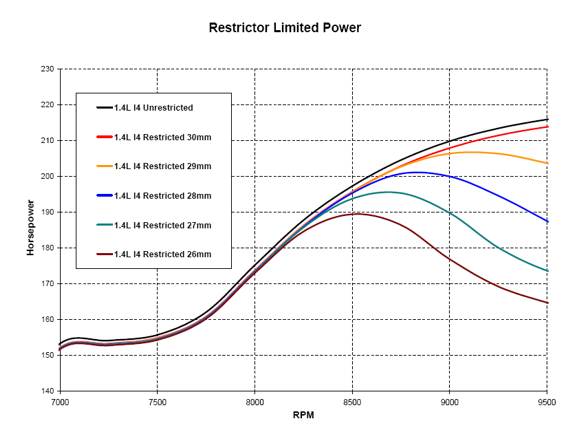Single Inlet Restrictor Function
Internal combustion engines combine fuel and air to produce horsepower. In the case of a gasoline engine, airflow is always the limiting factor. A single inlet restrictor predictably and controllably limits airflow and thereby power. Sanctioning bodies are increasingly mandating single inlet restrictors in an effort to predictably and controllably limit power. Raetech has developed a line of restrictors that have been optimized through computational fluid dynamics and designed to thrive in the harshest environments making them the most thoroughly engineered restrictors available for purchase.
Choke flow is the distinct limit when the restrictor will flow no more air, regardless of downstream vacuum. This occurs when the flow velocity reaches the speed of sound across the restricted area. The Raetech restrictor is designed to provide minimal effect up to choke flow and to achieve choke flow at the lowest possible pressure drop. Minimized pressure drop to achieve choke flow means an engine with a Raetech restrictor will have to work the least to achieve the power limits imposed by running a restrictor. Lesser restrictors will require running the motor in a higher rpm band to create enough draw to achieve the rules-limited amount of airflow. This increased rpm adds power-robbing friction along with wear and tear. Besides making more power, the best restrictor you can buy should save you money in the long run due to better engine life and longer intervals between rebuilds. The results of a restrictor on a simulated flow bench are shown below.

Engine Performance with an Inlet Restrictor
The basis of restricting an engine is to limit power to level the playing field (that's what the sanctioning bodies tell us at least). A single inlet restrictor will put a definite limit on peak power, but a well-designed restrictor will not greatly affect your power and torque below this limit. Performance curves for an unrestricted high-output 1.4L engine and several restricted versions of it are shown below. The only difference among them is the inlet restrictor diameter. These graphs show how effective an inlet restrictor is and why this concept is so enticing to sanctioning bodies.


